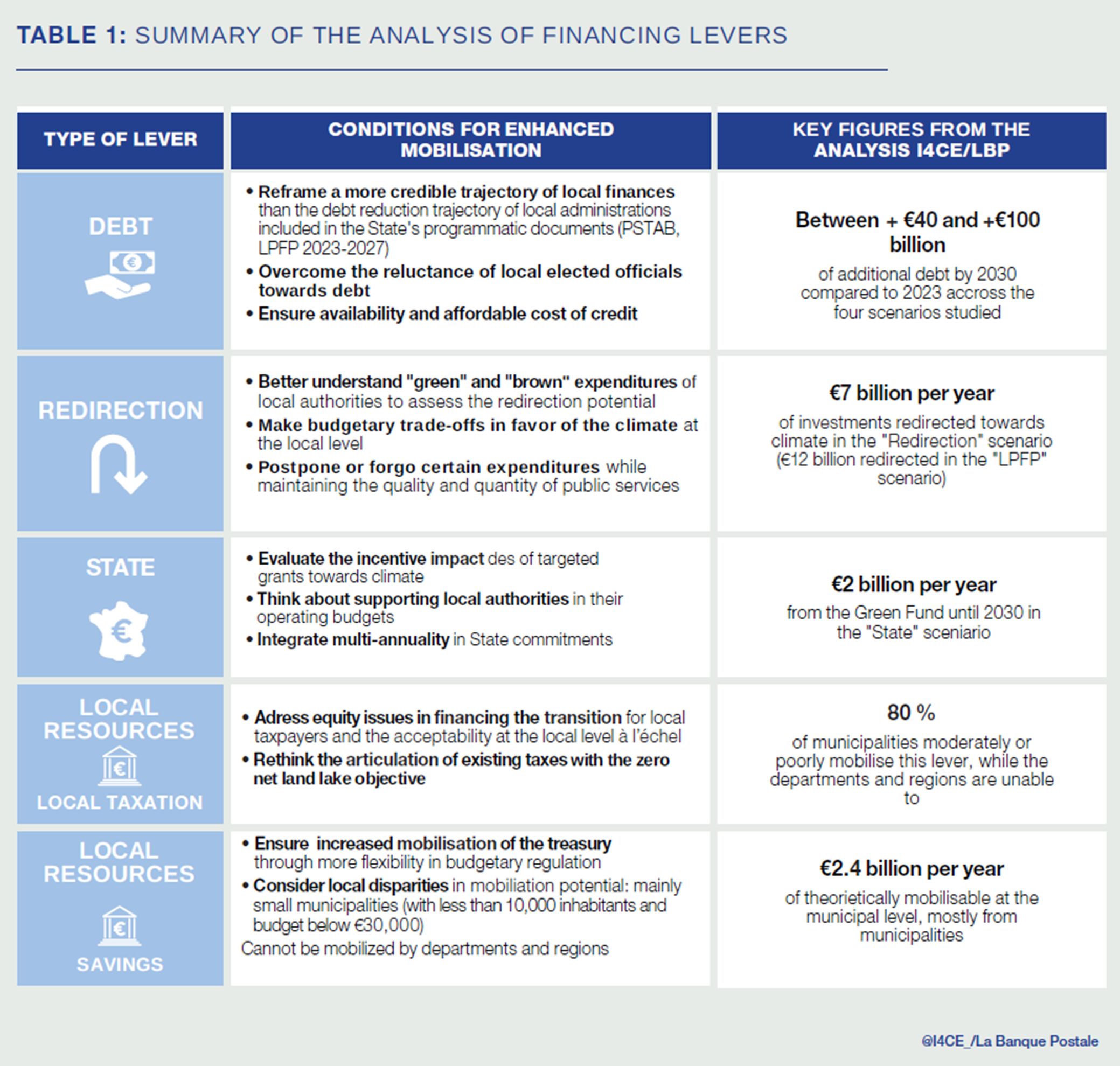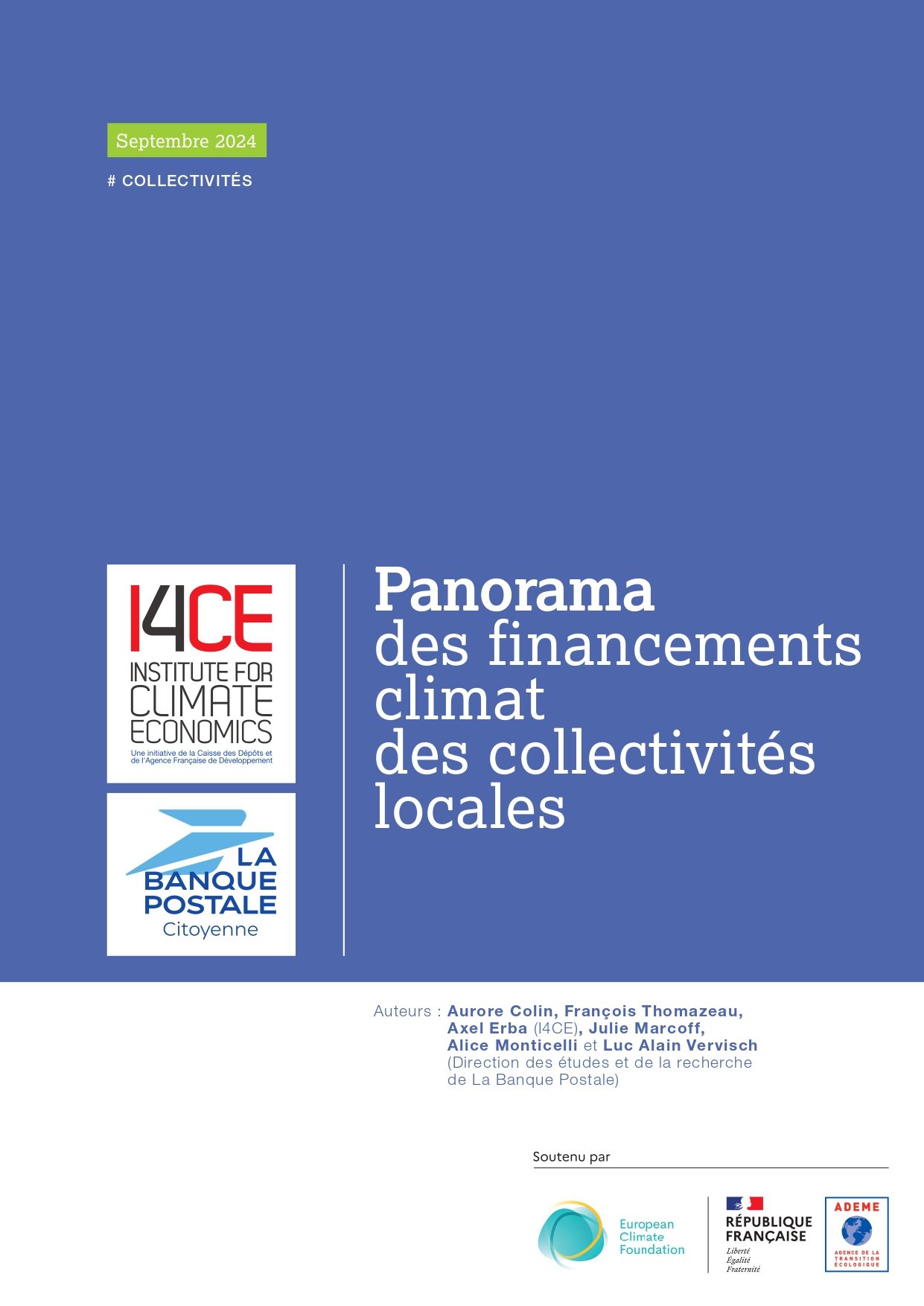Overview of Climate Financing for French Local Authorities
Report only available in french
A comprehensive and up-to-date overview of the challenge of financing the low-carbon transition at the local level in France
Local authorities have a major role to play in achieving France’s 2050 carbon neutrality goals, as set out in the Stratégie nationale bas-carbone (SNBC). Due to their property and responsibilities, they must make numerous climate investments, implement strategies and action plans, and deploy initiatives to mobilise local actors.
While the levers for decarbonising territories are becoming better known, the economic aspect of climate action at the local level remains relatively unexplored: are municipalities, inter-municipal bodies, départements, and regions —assuming they are willing—capable of investing at the level required by the needs outlined in the state’s own ecological planning documents?
Building of previous work, this study provides an overview of the economic and budgetary issues involved in financing local authority climate action. In so doing, it seeks to contribute to a number of ongoing debates :
- the debate on how to finance the low-carbon transition, of course, and on the distribution of effort between public and private actors, and, within the public sector, between the State and local administrations ;
- the debate on national steering of local finances, which, as it is the case for all public accounts, must now systematically take into account the climate emergency and its budgetary impacts;
- the debate on the nature of the State/Local Authorities dialogue and its evolution, particularly in the context of the “territorialisation of ecological planning” initiated a few months ago, which still lacks a financing component.
This study is intended to be updated over time, supplemented, and enriched in future versions. Other transition issues are now better documented and could complement the assessment of needs, particularly regarding France’s adaptation to the impacts of climate change. Some topics remain insufficiently explored or documented, such as the impact of the transition on local authorities’ operating expenses and revenues. Lastly, the scope of the study is limited to mainland France, thereby excluding overseas territories.
Local authorities are accelerating their climate-friendly investments, but must more than double them to align with green planning goals.
Local authority climate investments in the building, transport, and energy sectors reached €8.3 billion in 2022. They are increasing: +44% since 2017 (in current €). According to the latest available data, they will continue to rise in 2023, reaching €10 billion. This growth is largely driven by increased investments by local authorities in electric mobility (vehicles and charging infrastructure), public transport—both rail and urban—and the energy renovation of their buildings.

This positive trend must be nuanced, as a significant price effect has impacted the building and public works sectors in recent years. Furthermore, this effort must be significantly accelerated to meet France’s climate objectives.
Local authorities’ climate-related investment needs in the building, transport and energy sectors are estimated at an additional €11 billion a year on average by 2030, compared with 2022. These needs are primarily related to the decarbonisation of local authorities’ property and equipment, and financing transport infrastructure. They represent a minimum, as they do not include all sectors of ecological planning, nor the possible operating expenses required to implement local climate policies.

The largest category of investment needs estimated in this study concerns the development of modal transfer infrastructure (+€4.0 billion per year), which includes public transport, railways, waterways, and cycling facilities. The second category is energy-efficient renovation of public buildings owned by local authorities (+€3.2 billion per year). Investment needs also concern the development of electric mobility (+€1.8 billion per year), through the purchase of electric vehicles to decarbonise local vehicle fleets and the deployment of charging infrastructure throughout the territory. The fourth category pertains to energy, involving the modernisation of public lighting and the development of district heating networks (+€1.2 billion per year). Finally, local authorities will likely need to significantly increase their funding for the energy-efficient renovation of social housing (+€600 million per year).
The necessity to accelerate climate-related investments concerns all levels of local authorities. In line with its share of public investment, the communal bloc, composed of municipalities, inter-municipalities, and syndicates, accounts for nearly two-thirds of the investment effort, amounting to an additional €7 billion per year on average by 2030. Although the départements are responsible for less investment, the gap that they need to close is substantial: their needs are estimated at an additional €2 billion per year, representing more than a threefold increase compared to 2022. These include the decarbonisation of their property and equipment (buildings and vehicles), as well as the development of cycling networks on the roadway they manage. Lastly, the needs of regions are also estimated at nearly an additional €2 billion per year by 2030, almost doubling their 2022 level (+80%). This effort is mainly focused on the decarbonisation of their property and rail transport. It should be noted that this estimate does not take into account cross-financing by local authorities, in particular those allocated by regions and départements to finance communal investments.

Breaking through the climate investment barrier at the local level implies a new economic equation in the financing of french local public action
The increase in investments dedicated to climate change mitigation is part of a broader landscape, that of local public action and its financing. The aim of this study is therefore to align the identified needs for carbon neutrality with a forward-looking assessment of local authorities’ financing capacities, as reflected in their accounts at the end of 2023. Four levers have been analysed through four contrasting and deliberately theoretical scenarios. All of these levers must be mobilised simultaneously through joint action by the State and local authorities:
1 – Local authorities must accelerate the redirection of their investments towards climate action today, through political and budgetary choices that favor climate initiatives over other projects. The amount of investments redirected towards climate action reaches €7 billion per year in the “Redirection” scenario. A shift in political choices is already underway within local authorities but it needs to be amplified: between 2017 and 2023, climate investments rose from 9.5% to 13% of total capital expenditures.
2 – Increased use of borrowing to finance climate-related investments is also an essential lever. The debt levels of local authorities are projected to rise by 2030 under all our scenarios. Mobilising this financing lever requires an alignment of actions among local authorities (choosing to borrow when possible), the State (providing favorable signals), and financial institutions (ensuring credit availability).
3 – Local resources, primarily related to taxation, fees, and asset disposals, must be mobilized to a greater extent in order to finance climate-related investments. However, their potential is difficult to estimate on a national scale, as these levers cannot be utilised in the same way by all local authorities; the ability to mobilise them depends on local economic and political contexts. Moreover, the use of these resources raises questions of fairness in the financing of the transition, of equity among local taxpayers and users, of acceptability, and of articulation with other environmental objectives (e.g., the zero net land take objective).
4 – State allocations supporting the transition, must be made more stable and predictable over time. The creation of the “Green Fund” and its subsequent increase have sent a positive signal to local authorities regarding the priority given to projects that make a positive contribution to climate policies. It is now up to the State to stabilise this instrument in a context of budgetary uncertainty and to make it more effective and predictable for local decision-makers.
The State’s responsibility: to establish a credible framework at the national level and to adapt it to local contexts
The political and budgetary context makes it uncertain what decisions will be taken in the coming weeks and months as part of the government’s upcoming finance bill. The challenge for local public action is twofold: to ensure that the signal in favour of the transition sent to local players through the creation of the Green Fund is not blurred by budget cuts with poorly assessed consequences; and to maintain a context favorable to dynamic local investment.
The framework offered by the 2023-2027 Public Finance Programming Act (LPFP) and the April 2024 Stability Program (PSTAB) appears, according to our analysis, incompatible with an acceleration in local investment commensurate with the identified needs. These documents assume a rapid reduction in local authority debt through a sharp slowdown in their operating expenditures and a decrease in their investment spending in the coming years. Consequently, the resulting local finance trajectories are incompatible with the climate investment needs currently put forward by I4CE and other similar studies unless one envisions a rapid reassertion of state control over local choices, with a major impact on the quantity and quality of public services offered to the population outside the “climate” sphere. Therefore, a new and more credible trajectory for local finances must be defined in dialogue with local actors and in coherence with the multi-year financing strategy for the ecological transition, which is expected to be adopted this fall.
The territorial implementation of ecological planning, initiated in 2022, provides a framework to renew the budgetary dialogue between the State and local authorities. The study highlights significant territorial disparities in the ability to mobilize the various funding levers available to local authorities: it is through the analysis of each territory, identifying its precise needs and capabilities, that the economic equation can be established to ensure the long-term acceleration of local climate action.

A methodological appendix in french will be added in September 2024
Supported by




